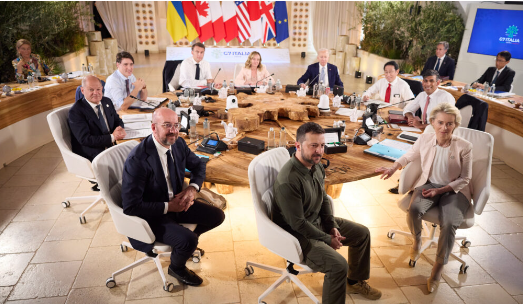Will G7’s $50 Billion Plan Aid Ukraine Effectively?
During the G7 summit that Italy held, Italian Prime Minister Giorgia Meloni announced a big $50 billion plan to help Ukraine. In a joint session with other leaders, including U.S. President Joe Biden and Ukrainian President Volodymyr Zelenskyy, this choice was made.
Details of the Financial Agreement
The $50bn fund will be paid for by the gains made from selling about $300bn in frozen Russian assets, most of which are held in Europe. Ursula von der Leyen, President of the European Commission, said that all seven G7 countries will contribute to this multiyear loan plan. The package is meant to help Ukraine with things like defense, rebuilding, and making the country’s energy system stronger.
Strategic Importance and Challenges
Olaf Scholz, the chancellor of Germany, praised the deal as a historic step that showed the G7 was united and ready to fight Russian aggression. There could be problems with the deal, though, if the frozen Russian assets are unfrozen at any point. This is because it would change where the money is coming from. Also, the plan could make things worse because Maria Zakharova, a spokeswoman for the Russian Foreign Ministry, said it would have bad effects on Europe.
Broader Implications and Additional Agreements
At the same time, the U.S. and Ukraine signed a security deal that will last for 10 years. This will improve Ukraine’s defenses and help it get into NATO. This move comes during ongoing conflicts and shows that the rest of the world is serious about protecting Ukraine’s autonomy. This financial and strategic backing from the G7 during a time of global unrest is a turning point in international relations that will help Ukraine in its ongoing conflict with Russia.
About G7 nations
- Formation and Evolution: The leaders of Canada, France, Germany, Italy, Japan, the United Kingdom, and the United States formed the Group of Seven (G7) in 1975. It is an international organization. The G7 used to only talk about economic problems, but now they talk about a lot of different global issues, such as security and environmental policy.
- Membership Changes and Representation: Russia joined the G7 in 1998, which made the G8. However, it was kicked out of the group in 2014 after taking over Crimea. The European Union (EU) is also a part of the G7, but it doesn’t host or lead talks. The G7 countries make up about 10% of the world’s people and 40% of its GDP.
- Meetings and Presidency: G7 summits and talks are casual, and they don’t make official statements. The G7’s presidency changes every year between its member countries. This lets the country in charge set the agenda based on the most important global problems.
Month: Current Affairs - June, 2024
Category: International / World Current Affairs • Summits and Conferences







